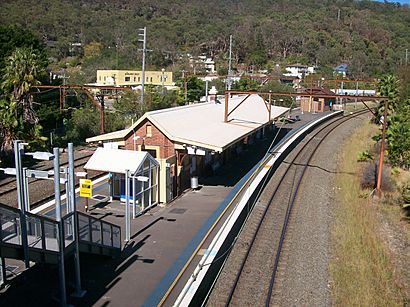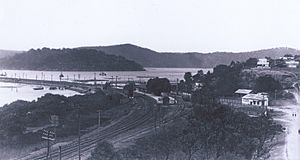Hawkesbury River railway station facts for kids
Quick facts for kids
Hawkesbury River
|
|||||||||||
|---|---|---|---|---|---|---|---|---|---|---|---|

Southbound view
|
|||||||||||
| Location | Dangar Road, Brooklyn Australia |
||||||||||
| Coordinates | 33°32′49″S 151°13′35″E / 33.5468444°S 151.2263053°E | ||||||||||
| Owned by | Transport Asset Holding Entity | ||||||||||
| Operated by | NSW TrainLink | ||||||||||
| Line(s) |
|
||||||||||
| Distance | 57.4 km (35.7 mi) from Central | ||||||||||
| Platforms | 2 (1 island) | ||||||||||
| Tracks | 3 | ||||||||||
| Connections | |||||||||||
| Construction | |||||||||||
| Structure type | Ground | ||||||||||
| Disabled access | No | ||||||||||
| Other information | |||||||||||
| Station code | HKR | ||||||||||
| Website | Transport for NSW | ||||||||||
| History | |||||||||||
| Opened | 1870 | ||||||||||
| Electrified | Yes | ||||||||||
| Previous names | Brooklyn | ||||||||||
| Traffic | |||||||||||
| Passengers (2013) | 330 (daily) (Sydney Trains, NSW TrainLink) | ||||||||||
| Rank | 204 | ||||||||||
| Services | |||||||||||
|
|||||||||||
| Official name | Hawkesbury River Railway Station group; Brooklyn Station | ||||||||||
| Type | State heritage (complex / group) | ||||||||||
| Designated | 2 April 1999 | ||||||||||
| Reference no. | 1166 | ||||||||||
| Type | Railway Platform/ Station | ||||||||||
| Category | Transport - Rail | ||||||||||
| Builders | New South Wales Department of Railways | ||||||||||
Hawkesbury River railway station is a special train station in Brooklyn, Australia. It's located on the southern side of the Hawkesbury River. This station is part of the Main North and Central Coast–Newcastle train lines. It's also known as the Hawkesbury River Railway Station group or Brooklyn Station. Because it's so old and important, it's listed on the New South Wales State Heritage Register since April 2, 1999.
Contents
Station History
The train line connecting Sydney and Newcastle was built in two main parts. The first part, from Sydney to the Hawkesbury River, opened on April 7, 1887. The station was the end of the line on the south side of the river for a while.
The second part of the line, from Newcastle to the north side of the Hawkesbury River, opened in January 1888. The full line between Sydney and Newcastle was finally connected when the Hawkesbury River Railway Bridge opened in 1889.
How the Station Got Its Name
When the station first opened, it was called "Hawkesbury River." But its name changed several times over the years! It was renamed "Brooklyn" in 1888, then "Hawkesbury River" again in 1889. In 1890, it became "Hawkesbury," and finally, in October 1906, it went back to being called "Hawkesbury River." People in the area also called it "Peats Ferry" or "Flat Rock" in the early days.
River Wharf: A Temporary Stop
Before the big bridge was built, there was another temporary train stop called "River Wharf." This stop was on Long Island, connected by a path to the mainland. Trains would stop here, and passengers and goods would switch to ferries. These ferries would take them across the river to another wharf on the northern side. This allowed people to continue their journey while the main bridge was still being built.
The River Wharf stop was used from August 15, 1887, until the Hawkesbury River Railway Bridge opened in 1889. Even today, you can still see parts of the old platform on Long Island, though the wharf itself is gone.
Station Upgrades Over Time
Hawkesbury River station became very popular for day trips and fishing. The first timber station building was replaced in 1903 with the brick building you see today. This new building was designed for an "island platform," which is a platform with train tracks on both sides.
In 1912, the train line was doubled, meaning there were two tracks instead of one. The station was updated with an island platform, a brick building, and special tracks for trains to wait or store goods. A footbridge was also added so people could easily get to the platform.
Later, in 1959, the train line became electric. This meant steam trains were replaced by electric ones. The station's platforms, bridges, and footbridge were changed to fit the new electric trains. The old signal box, which controlled the train signals, was closed in the late 1980s or early 1990s, and signals are now controlled from a central office.
In Movies and Music
You might have seen Hawkesbury River station before! It appeared in Jimmy Barnes' music video for his song Still On Your Side in 1987. It was also featured in two episodes of the TV show Home and Away.
Train Platforms and Services
Hawkesbury River station has one island platform, which means it has train tracks on both sides.
Trains at this station are run by NSW TrainLink. They are part of the Central Coast & Newcastle Line.
| Platform | Line | Stopping pattern | Notes |
| 1 |
NSW TrainLink
|
Services to Sydney Central | |
|---|---|---|---|
| 2 |
NSW TrainLink
|
Services to Gosford, Wyong & Newcastle |
Getting Here by Bus
You can also reach Hawkesbury River station by bus. Transdev NSW operates one bus route that stops here:
- 592: From Hornsby station to Mooney Mooney.
What Makes This Station Special?
Hawkesbury River station is very important because of its history and its beautiful location. It's listed on the New South Wales State Heritage Register.
Unique Location
The station is in a very scenic spot right next to the Hawkesbury River. You can see amazing views of the water and Long Island. From the station, you can also see the land bridge to Long Island and the entrances to the old and new Long Island tunnels. This makes it a great place to see some of the amazing engineering that went into building the train line. Its location right by the water is quite rare for a train station in New South Wales.
Historic Buildings and Features
The station has several old and interesting parts:
- Station Building: The main building was built in 1910. It's made of brick with a corrugated iron roof. It has large awnings (roof-like structures) that stick out over the platform, supported by cool cast iron brackets. Inside, it has painted walls, wooden floors, and even original wooden seating in the waiting room. There's also an old signal box attached to one end.
- Platform: The platform was finished in 1887. It curves gently and has both old brick and newer concrete sections. You'll find a World War II honour roll (a list of people who served) and an old cast iron drinking fountain on the platform.
- Footbridge: At the northern end of the platform, there's a steel footbridge from the early 1900s. It connects Brooklyn Road to the platform and the wharf. It was made taller when the electric trains started running.
- Wharf: A small timber wharf (a wooden dock) is on the western side of the station.
- Store Room: At the southern end of the platform, there's a brick building from around the 1930s. It's now used by staff.
- Water Spout: South of the platform, you can see an old water spout. This was used to fill up steam locomotives with water a long time ago! It's a cast iron structure on a concrete base.
Why It's Heritage Listed
Hawkesbury River station is important for many reasons:
- History: It was the end of the train line from Sydney for two years until the big Hawkesbury River bridge was finished in 1889. This bridge was a huge engineering achievement! The station also helped the town of Brooklyn grow as a place for railway workers to live.
- Design: The station building, island platform, and footbridge are good examples of how train stations were built in Sydney between 1892 and 1929. The station building is especially well-preserved.
- Rarity: While the station building style is common, its unique waterside setting makes it very special and rare. It's part of a larger, important railway area around the Hawkesbury River, which includes tunnels, bridges, and old worker homes.
Images for kids



